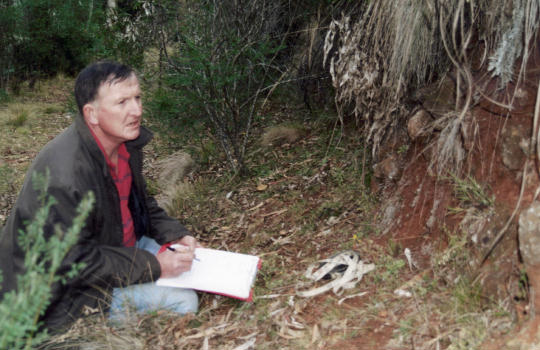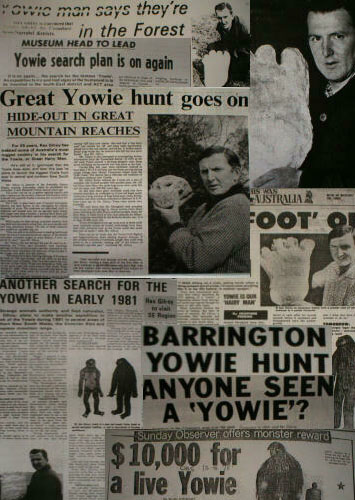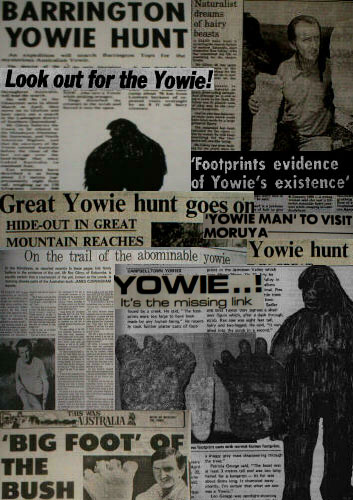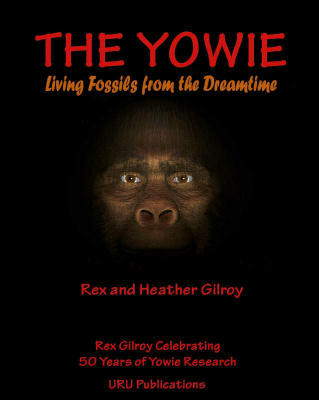Troublesome Tools
This article is composed of extracts from the 2007 book:
“The Yowie Mystery - Living Fossils From The Dreamtime".Copyright (c) 2007 Rex Gilroy, Uru Publications.
We believe that such tools exist in Australia, as yet unknown, and which in any case would go unrecognised by a scientific establishment which continues to look to Africa for our human beginnings.
This is the purpose of this chapter, for we intend to show that, not only do primitive ‘eoliths’ [ie Dawn Tools] exist here, but that archaic tools manufactured by Homo erectus, further demonstrate a pre-Aboriginal Stone-Age history for Australia, and that Homo erectus, the Yowie, or “hairy man” of our Aboriginal people, continues to manufacture modern-day stone implements at his lairs, hidden deep within the more remote regions of our eastern mountain ranges.
Photo Left: Rex Gilroy at work in the field. Here he is carrying out a detailed study and measurement of a volcanic strata bank deep in the Nundle State Forest, south-east of Tamworth, New South Wales, on Monday 9th May 2004, where primitive Homo erectus-type ‘dawn tools’ had been recovered during a previous visit here. These ‘eoliths’ date back to early Pleistocene times. Photo copyright © Rex Gilroy 2007.
While ancient naturally-flaked stones possibly used by the first ancestral hominids would be virtually impossible to identify, deliberately-flaked stones are another matter, particularly if found in association with hominid fossil remains. The very presence of Eolithic ‘tools’ in the Australian archaeological record, while unacceptable today, will be more acceptable to future archaeologists unfettered by our present-day “political correctness” stupidity which denies any evidence of a pre-Aboriginal past.
These pre-Australoid, indeed pre-Homo erectus eoliths, like eoliths found elsewhere in the world, are often so ancient and weathered that their crudely worked surfaces are hardly recognisable from lumps of stone. At the time of writing of my first book, “Mysterious Australia” in 1995, I spoke of having found eoliths near the Bathurst giant hominid ‘megatool’ sites, at sites on the Blue Mountains, on the shorelines of long extinct Pleistocene lake systems of the New England district of New South Wales, as well as on the Murray River of South Australia
. I have since recovered these primitive ‘tools’ at sites over a wide area of Queensland, Central Australia and Western Australia. It seems certain that ancestral hominids once spread across much of this continent. These ‘tools’ are evidence of an Australian Old Stone-Age which, at the time of writing “Mysterious Australia”, were still largely theoretical specimens to me, until the discovery of actual Homo erectus skull-types, such as the Mudgee, New South Wales, ‘archaic’ specimen [June 1997], which was unearthed in the vicinity of a number of eoliths.
Just prior to this major find, we uncovered a large concentration of these ‘dawn tools’ on the former shoreline of an extinct giant Ice-Age lake system on the edge of Tamworth Township, and on the southern shore of this former lake 17km south of the city at Timbumburi. Others later turned up in the Nundle area to the south-east.Photograph right: Aboriginal Girl wearing a Kangaroo hide Garment. Photographer Unknown. I will credit anyone who owns this photograph.
At another former Ice-Age site in the Liverpool Plains far to the west of Tamworth, a crude ‘dawn tool’ – a chopper used for smashing bones to obtain the marrow inside – was found in the same deposit as a fossilised giant kangaroo leg bone. Throughout the New England district these eoliths were found in the earliest sediments of extinct lakes and river systems, always in deposits pre-dating Aboriginal times. The makers of these tools appear to have been of average height, ie 1.5 to 2 metres.
Yet Australian petrologists [scientists who study rocks and stone tools] will readily dismiss these dawn tools as unprovable, mostly because the existence of eoliths in Australia implies the presence here of primitive pre-Aboriginal races, such as ‘archaic’ Homo erectus, even proto-erectus hominids, and earlier beings from the pre-Pleistocene era, that is the Pliocene. Yet the Bega district skull endocast dates from the very beginning of the Pliocene, suggesting the race which it represents extends back into the late Miocene period.
Indeed, the Australian eoliths are “troublesome tools” which no ‘respectable’ scientist will touch, for fear of losing their ‘credibility’. However, the authors are amateurs who do not have a government paid job to lose if they ‘step out of line’ and as amateurs we have open minds receptive to any new possibilities or discoveries which could enhance the history of our continent’s ancient past. For many years I had been finding Eolithic tools at various locations out on Narrow Neck Plateau, which juts out to the south-west of Katoomba to overlook the Burragorang Valley to the south and Megalong Valley on its western side.
There is plenty of evidence to show that, back in early Pleistocene times, this great plateau was an area covered in lush vegetation and a swampland that extended from north to south for about 1km. I had been picking up Eolithic scrapers, choppers and other such implements along the former shoreline of this swamp, which had vanished with the Pleistocene, leaving a deep gully. At one particular area overlooking this former swamp I had for several years been finding numbers of Eolithic tools being worn to the surface of a track and also from out of the base level of an embankment exposing old Pleistocene strata, which geologists date to the very beginning of this period, ie around 2 million years BP.
The manufacturers of these ‘tools’ puzzled me. Then, on January 7th 2005, as already stated earlier in this book, I recovered the badly weathered, ironstone mineralised skull of a proto-Homo erectus, the obvious maker of these tools – and we are of course referring to a population rather than an individual. Small Eolithic specimens from this area are suggestive of pygmy implements, and these are of the same age as the ‘proto-erectus’ specimens. However, there is another mystery out there on Narrow Neck, in the form of recently-manufactured stone tools of Homo erectus types and many are to be found in a gully down which a creek descends into the Megalong Valley, which since the Pleistocene, has offered access to and from the summit of this scrub-covered plateau.
What appear to be some very small stone tools have also been found which may or may not belong to live pygmy folk claimed to have been sighted from time to time out on the plateau, and they have been part of Megalong Valley folklore for generations of European settlement there. Yowie sightings are also claimed to have occurred out on the ‘Neck’ from time to time and these animal-hide clad living Homo erectines, males and females alike, even children, continue to be sighed in the more remote areas of the Megalong Valley, bordering on the vast, mysterious Burragorang.
We believe that, with the fossil evidence already presented, that we have demonstrated that the first modern humans, Homo sapiens, evolved here in Australia from Homo erectus by at least 400,000-300,000 years BP well before they appeared elsewhere in the world. Endless arguments have raged among archaeologists over these ‘tools’ particularly in Africa, where the argument is over whether they were manufactured by primitive Homo habilis or Australopithecus. Many ‘experts’ just dismiss eoliths out of hand in a most unscientific manner.Yet scientists who dispute the eolith theory should remember that the development of stone, bone and wooden tools was a gradual process tied up with the evolution of the hominid brain and that there already exists an evolutionary picture for the progressive development of stone tools, from primitive chipped specimens of the Old Stone-Age [Palaeolithic period] through to the edge-grounding and advanced chipping and flaking developments of the more recent Neolithic or New Stone-Age, to support this hypothesis. Dawn tools therefore had to have existed.
As already mentioned, the first eoliths were nothing more than crude, jagged stones found by our wandering ape-like ancestors and used for hammering or scraping and cutting purposes. Gradually our ancestors learnt how to chip and flake stones deliberately to create a desired cutting edge. Australian scientists will ignore these dawn tools and the implications they hold for Australian human prehistory, but the Aboriginal people maintain a different view. Their elders speak of the “old ones”, primitive beings not yet completely human who arose on this continent in the dawn mists of the long-ago Dreamtime to wander the land. We believe the evidence speaks for itself, to show that the answers to the mystery of when we became human should not be sought in Africa but Australia!
“The Yowie Mystery - Living Fossils From The Dreamtime".
“The Yowie Mystery - Living Fossils From The Dreamtime". Special Dedication. The Authors dedicate this book to the late Charles Melbourne Ward F.Z.S.; F.R.Z.S. known to his great many friends simply as ‘Mel’. Together with his wife Halley, he operated a natural history museum in the grounds of the Hydro Majestic Hotel at Medlow Bath for many years and also another established at Echo Point, Katoomba. It was ‘Mel’ who first taught me how to collect, record and study natural history specimens, beginning when I was aged 11 years old on holidays with my parents at Katoomba in 1954. Thereafter, every school holidays spent in Katoomba began with a visit to ‘Mel’ at his Medlow Bath Museum to inform him how my fledgling natural science studies were progressing!
As a result and after my parents moved from our Lansvale [western Sydney] home to Katoomba, the Gilroys and Wards became close friends. There was hardly a week which did not see me peddling my pushbike from our North Katoomba home up the Great Western Highway to see ‘Mel’ at his museum for more instruction. Mel Ward possessed a wide knowledge of the culture of the Australian Aborigines and that of the former local Blue Mountains tribes in particular.
He was also a firm believer in the “Hairy Man” and supported my researches in this regard. At my 21st birthday party, held at the Homesdale Function Centre, at Katoomba on Saturday night 8th November 1964, I well recall how my old friend, in front of a large gathering, congratulated me on my researches and the large natural science collection that I was forming and then said: “You’ve done a fantastic job Rex, BUT IT’S ABOUT TIME THAT YOU STARTED MAKING SOME BLOODY MONEY OUT OF IT” in a loud voice that brought the house down!
That following week, together with my father Mr W.F. [Bill] Gilroy, I began a search of local venues, which soon resulted in the acquisition of the lease from the Blue Mountains City Council of the Mt York Tea Rooms, outside Mt Victoria, the rest they as “is history”. Two years late, on October 6th 1966, Mel Ward was dead, having passed away in his sleep. He once said to my father that I was “the Mel Ward of Tomorrow” and I am certain that Mel would be pleased to know that I have indeed followed in his footsteps.
Mel led an adventurous life. The son of Hugh J. Ward, a famous Shakespearean actor of the early 20th century, Mel was encouraged to go on the stage by his father but Mel developed a passion for the natural sciences and his wealthy parents helped him become established. In his lifetime of achievement, Mel became recognised as a world authority on Crustaceans and an anthropologist. He was made a Fellow of the Royal Zoological Society of New South Wales and was pleased when I too became a member of the Society in 1963. He encouraged me, not long before his death, to take on the Presidency of the Society’s Entomological section, where I served for three years from 1966 to 1969.
That he achieved so many things in the course of his lifetime researches is remarkable, because like this author, he was an amateur with not one university degree to his name! I am certain that my old friend would be delighted at the fact that, together with heather, I am now writing and publishing book on the subjects he loved and on the Yowie in particular. He taught me never to blindly follow the textbook and dare to question dogmas and not be told what to think! I have certainly followed his advice. Knowing Mel Ward as I did I know he would wholeheartedly approve of the scientific approach of this book, therefore “Mel”
This Book is for You!
Rex Gilroy - Australian Yowie Research Centre, Katoomba, NSW.
Monday 25th June 2007I also present sensible advice to any future would-be Yowie investigators. The reader will also be awed at the great many discoveries my wife Heather and I have made in all our years together in the field. I feel privileged to be the founder of Yowie research and to have encouraged other, sensible researchers to follow my example. The search for surviving relict hominids in remote, hidden regions of the world, has been called the “last great search”, and it is both a fascinating and exciting one. Rex Gilroy may be contacted at the Australalian Yowie Research Centre, PO Box 202, Katoomba. NSW 2780. Ph 02 4782 3441 or email New Email Address as of June 2009 randhgilroy44@bigpond.com on or visit our website : http://www.mysteriousaustralia.com/ or http://www.australianyowieresearchcentre.com/ or http://www.rexgilroy.com/
Newspaper Articles on Rex Gilroy's Lifetime Search for the Australian Yowie
Newspaper Articles on Rex Gilroy's Lifetime Search for the Australian Yowie
Aboriginal/Koori Names for the Australian Yowie
To present the Yowie mystery in its proper context, relict hominid evidence from south-east Asia, New Guinea, other west Pacific Islands and New Zealand is revealed, demonstrating how the ancestors of these ‘manimals’ once spread out across the earth via land-bridges that formerly joined Australia/New Guinea/New Zealand with what is now island south-east Asia to the Asian mainland.
“Hairy man” was a name given by the Aborigines to any non-Aboriginal race with which they shared this continent, but the term centred primarily upon at least three basic forms. These forms were either the height of an average human being, an enormous man-like and also ape-like form. All were known by different names Australia-wide, but all meant either “hairy man” or “great hairy man”.






